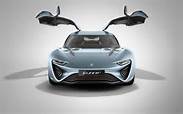In a breakthrough that is bound to catch the attention of the oil industry and even electric car makers, a company has just gained approval for its ‘salt water’ powered car in Europe.
A car called the Quant e-Sportlimousine that was presented at the 2014 Geneva Motor Show is the first electric car powered by salt water and is now certified for use on European public roads.
The e-Sportlimousine, built by the German company Quant, runs on an electrolyte flow cell power system made by NanoFlowcell that generates a staggering 920 horsepower, goes 0-62 mph in 2.8 seconds, and propels the car to a top speed of 217.5 mph!
What is an electrolyte flow cell you ask? According to Green Car Congress, “Flow cells or flow batteries combine aspects of an electrochemical battery cell with those of a fuel cell. The electrolytic fluids in flow cells—usually metallic salts in aqueous solution(salt water)—are pumped from tanks through the cell. This forms a kind of battery cell with a cross-flow of electrolyte liquid.”
“For the first time an automobile featuring flow-cell electric drive will appear on Germany’s roads,” said Nunzio La Vecchia, chief technical officer at NanoFlowcell, a company which designed the car. “We are extremely proud that as a small company we have developed such visionary technology and are now able to put it into practice. But this is only the beginning of our journey of discovery.”
A few months after making a debut at the 2014 Geneva Motor Show, the Quant e-Sportlimousine underwent an in-depth inspection and received official approval to be tested on public roads in Germany and Europe from certification provider TÜV Süd based in Munich, Germany.
The car is powered by the electrolyte flow cell power system, which is a part of the NanoFlowcell technology. The system works in a similar way to a hydrogen fuel cell, except for the fact that salt water is used for storing power. In particular, two liquids with metallic salts, which act as the electrolyte, are combined in such a way that the electrochemical reaction takes place. After that, electric motors use this reaction to generate electricity, which is then stored and distributed by super capacitors. The efficiency of this system reaches 80%, since the car has almost no moving parts in it, and the produced waste heat is insignificant in comparison with cars powered by lithium-ion batteries.
The company claims that the Quant e-Sportlimousine can reach the speed of 350 km/h (217.5 mph), accelerate from 0-100 in 2.8 seconds and has maximum power of 920 horsepower (680 kW). Moreover, the car is claimed to be able to travel up to 600 km (373 mi) with a full tank, which is five times greater than with a conventional battery system. At the same time, the car is safe to drive and environmentally friendly.
However, the market price of the Quant e-Sportlimousine is estimated to exceed $1.7. It is not yet clear if the company plans to use the NanoFlowcell technology on more affordable cars, but it can be said for sure that this technology has a great potential and could be used in a wide range of applications which go beyond the automobile industry.
Using this platform, the e-Sportlimousine is able to produce a massive amount of power while emitting zero emissions. While the e-Sportlimousine is bound to be very expensive, there is hope for the electrolyte flow cell power platform to be used more practically in the future.
image_quant_05
This technology has potential uses for other industries as well, says NanoFlowcell spokesman Prof. Jens-Peter Ellermann, “The potential of the NanoFlowcell is much greater, especially in terms of domestic energy supplies as well as in maritime, rail and aviation technology. The NanoFlowcell offers a wide range of applications as a sustainable, low cost and environmentally-friendly source of energy.”
“Low cost”, that sounds good to me.
Check this thing out in action:









